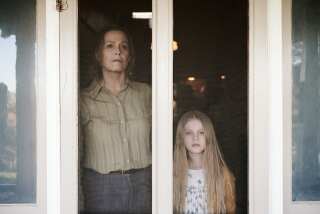A wonderland of ‘Alice’
More than a children’s classic, “Alice’s Adventures in Wonderland,” the 1865 book by Lewis Carroll, is ground zero for a multi-tentacled media franchise that has been going strong for nearly 150 years.
The Victorian forebear of a variety of 20th century artistic movements, drug cultures and fashion trends, it has inspired untold authors and musicians, served as the basis for dozens of film and television versions, and been tailored and twisted to fit almost every narrative form imaginable, from musical theater to soft-core porn to video game.
Tim Burton’s 3-D “Alice,” which opened March 5, has brought with it a DVD deluge of earlier adaptations. New and upcoming releases include an improbably star-studded 1933 Hollywood production with Cary Grant, Gary Cooper and many others (Universal, $19.98); Disney’s animated take from 1951 (a two-disc “un-anniversary” edition, $29.99); a 1966 version made for British television with Peter Sellers, John Gielgud and Michael Redgrave (BBC Warner, $14.98); an NBC TV movie from 1999 with Ben Kingsley, Miranda Richardson and Whoopi Goldberg (Vivendi, $19.93); and a miniseries that aired on the SyFy Channel last year with a somewhat oddball cast including Kathy Bates, Tim Curry and Harry Dean Stanton (Lionsgate, $19.98).
Besides attesting to the caliber of actors who have ended up in “Alice” projects over the years, the various productions suggest how malleable Carroll’s fable has always been. Though far from a classic, the upbeat 1951 Disney animated version remains the standard bearer for a kid-friendly “Alice.”
The black-and-white British TV film, directed by Jonathan Miller at the height of the Swinging ‘60s and featuring a Ravi Shankar score, avoids the expected psychedelic clichés, reveling in subtler druggy atmospherics.
The recent miniseries, in which a modern-day Alice is a martial-arts expert, fits with the ongoing revisionist vogue for empowered Alices. (In Burton’s film, she’s 19 and more action heroine than passive visitor.)
The most satisfying of all the reissues, the 1933 “Alice in Wonderland” -- actually the second sound-era “Alice,” after an obscure 1931 version -- is reasonably faithful to the original and, as such, gratifyingly weird. Combining elements of “Alice’s Adventures” and its 1872 sequel “Through the Looking-Glass,” the film was directed by the unheralded Norman McLeod; in almost every other respect, though, it was an A-list endeavor.
The screenplay is credited to Joseph L. Mankiewicz and William Cameron Menzies, both of whom would become important filmmakers in their own right. Menzies, already an Oscar-winning art director, was also responsible for the off-kilter sets and visual tricks.
The cast includes W.C. Fields as Humpty Dumpty, Cary Grant as the Mock Turtle, Gary Cooper as the White Knight and Edward Everett Horton as the Mad Hatter.
It would be misleading, though, to say that the film is full of recognizable faces, since most of the actors are masked, suited and heavily made up (in the spirit of the indelible original illustrations by John Tenniel). The actors get into the romper-room spirit that an “Alice” production invariably induces, but the film’s real pleasure is in the ingenuity of its old-school effects.
Of the other screen adaptations of “Alice,” the one that stands furthest apart from the pack is the 1998 stab by the master Czech animator Jan Svankmajer, a combination of live action and stop-motion animation in which the dream logic of Carroll’s story shifts decisively to nightmare. (It’s available on DVD through First Run Features, $29.95.)
And then, of course, there are the countless works that have simply been inspired by Carroll’s Alice. There are traces of her wild trip in films such as Jacques Rivette’s 1974 masterpiece “Celine and Julie Go Boating,” in which two Parisian friends wander into a mansion whose occupants are stuck in an eternal loop, and Guillermo del Toro’s “Pan’s Labyrinth” (2006), about a girl who discovers a fantasy underworld during the Spanish Civil War. “Alice in Wonderland” is also the founding text for alternate-reality tales such as “The Matrix” and “Lost.”
It’s no wonder that Carroll’s premise has proved so endlessly inspiring. In some ways, it is the most open-ended of templates. All versions of the Alice story are defined by that thrilling initial breach: down the rabbit hole, through the looking glass. What exactly we find on the other side remains up for grabs.
More to Read
The biggest entertainment stories
Get our big stories about Hollywood, film, television, music, arts, culture and more right in your inbox as soon as they publish.
You may occasionally receive promotional content from the Los Angeles Times.










